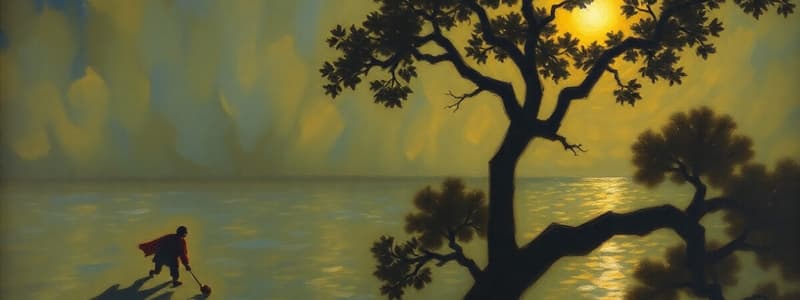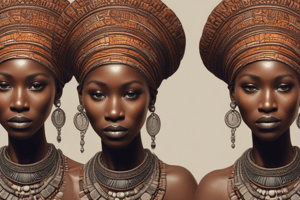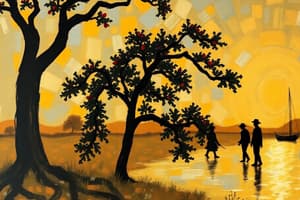Podcast
Questions and Answers
Such cultural interaction may result from factors including, but not limited to, ______, trade, war, conquest, and/or colonization.
Such cultural interaction may result from factors including, but not limited to, ______, trade, war, conquest, and/or colonization.
travel
Cultural interaction may include forms of artistic influence such as ______, appropriation, and stylistic revivals.
Cultural interaction may include forms of artistic influence such as ______, appropriation, and stylistic revivals.
spolia
Human migrations carried populations southward into central Africa and eventually across the ______ River Basin.
Human migrations carried populations southward into central Africa and eventually across the ______ River Basin.
Congo
The arts, major world religions, and international trade routes followed those paths and flourished in patterns of distribution seen in ______ today.
The arts, major world religions, and international trade routes followed those paths and flourished in patterns of distribution seen in ______ today.
Outsiders have often characterized, collected, and exhibited African arts as ______, ethnographic, anonymous, and static.
Outsiders have often characterized, collected, and exhibited African arts as ______, ethnographic, anonymous, and static.
In reality, Africa’s interaction with the rest of the world led to dynamic intellectual and artistic traditions that sustain hundreds of cultures and almost as many ______, contributing dramatically to the corpus of human expression.
In reality, Africa’s interaction with the rest of the world led to dynamic intellectual and artistic traditions that sustain hundreds of cultures and almost as many ______, contributing dramatically to the corpus of human expression.
Creative contributions of African life and arts are found in populations around the ______.
Creative contributions of African life and arts are found in populations around the ______.
Artistic practices were conveyed by and continue to be serviced by ______ patterns of interaction with populations around the world and through time.
Artistic practices were conveyed by and continue to be serviced by ______ patterns of interaction with populations around the world and through time.
The purposes and functions of African art are compared to the art of other cultures in different time periods and _____?
The purposes and functions of African art are compared to the art of other cultures in different time periods and _____?
Unit 6 focuses on using _____ analysis to better understand the artistic traditions of African cultures.
Unit 6 focuses on using _____ analysis to better understand the artistic traditions of African cultures.
Students may confuse visual analysis with contextual analysis by mentioning the form, style, materials, ____ , or content itself.
Students may confuse visual analysis with contextual analysis by mentioning the form, style, materials, ____ , or content itself.
When preparing for the AP Exam, students should begin by identifying visual _____ of unfamiliar works.
When preparing for the AP Exam, students should begin by identifying visual _____ of unfamiliar works.
The significance of similarities and differences in African art helps to understand its rich artistic _____?
The significance of similarities and differences in African art helps to understand its rich artistic _____?
Students should explain how or why visual elements were _____ in the creation of a work of art.
Students should explain how or why visual elements were _____ in the creation of a work of art.
On the exam, students may be asked to explain how and why context influences artistic _____?
On the exam, students may be asked to explain how and why context influences artistic _____?
To hone art historical skills, students are given the opportunity to provide works _____ of the image set.
To hone art historical skills, students are given the opportunity to provide works _____ of the image set.
Performances of objects are accompanied by ______ and music.
Performances of objects are accompanied by ______ and music.
Cultural protocols acknowledge and ensure the efficacy and appropriateness of artistic experience in ______.
Cultural protocols acknowledge and ensure the efficacy and appropriateness of artistic experience in ______.
The arts of authority legitimate traditional ______.
The arts of authority legitimate traditional ______.
Leaders’ histories and accomplishments are often entrusted to historians, ______, and elders.
Leaders’ histories and accomplishments are often entrusted to historians, ______, and elders.
African histories, often sung or recited, are traditionally the responsibility of ______.
African histories, often sung or recited, are traditionally the responsibility of ______.
African art is sung, danced, and presented in ______ experiences for designated audiences.
African art is sung, danced, and presented in ______ experiences for designated audiences.
Personal identity, social status, and relationships are delineated by ______ choices and artistic expression.
Personal identity, social status, and relationships are delineated by ______ choices and artistic expression.
Education, incorporation into adulthood, and civic responsibility are marked by the creation, manipulation, and ______ of art objects.
Education, incorporation into adulthood, and civic responsibility are marked by the creation, manipulation, and ______ of art objects.
African art objects that are similar in form are often grouped with works that come from the same ______.
African art objects that are similar in form are often grouped with works that come from the same ______.
The name of the artist and the date of ______ may not be known or acknowledged.
The name of the artist and the date of ______ may not be known or acknowledged.
The Africa often comes from ideas promulgated by non-______ since the 9th century.
The Africa often comes from ideas promulgated by non-______ since the 9th century.
The study of art history is shaped by different theories and interpretations of art and art making that change over ______.
The study of art history is shaped by different theories and interpretations of art and art making that change over ______.
These theories and interpretations may be used, harnessed, manipulated, and adapted to make an art-historical ______.
These theories and interpretations may be used, harnessed, manipulated, and adapted to make an art-historical ______.
Although interpretation of some of this art is ______ at best, the clarity and strength of design is obvious.
Although interpretation of some of this art is ______ at best, the clarity and strength of design is obvious.
The Conical tower and circular wall of Great Zimbabwe were built by the ______ peoples.
The Conical tower and circular wall of Great Zimbabwe were built by the ______ peoples.
The Great Mosque of ______ is a notable architectural structure in Mali.
The Great Mosque of ______ is a notable architectural structure in Mali.
The Great Mosque of Djenné was founded around ______ ce.
The Great Mosque of Djenné was founded around ______ ce.
The wall plaque from Oba’s palace belongs to the ______ peoples.
The wall plaque from Oba’s palace belongs to the ______ peoples.
The Sika dwa kofi is associated with the ______ peoples of south central Ghana.
The Sika dwa kofi is associated with the ______ peoples of south central Ghana.
The Ndop, a portrait figure of King Mishe miShyaang maMbul, belongs to the ______ peoples.
The Ndop, a portrait figure of King Mishe miShyaang maMbul, belongs to the ______ peoples.
The Power figure, known as Nkisi n’kondi, comes from the ______ peoples.
The Power figure, known as Nkisi n’kondi, comes from the ______ peoples.
The Great Mosque of Djenné was rebuilt between ______ and ______ ce.
The Great Mosque of Djenné was rebuilt between ______ and ______ ce.
The wall plaque from Oba’s palace dates back to the ______ century ce.
The wall plaque from Oba’s palace dates back to the ______ century ce.
The Ndop figure represents a ruler, specifically a ______ of the Kuba peoples.
The Ndop figure represents a ruler, specifically a ______ of the Kuba peoples.
Artistic decisions about form, style, materials, content, function, and/or context of a work of art elicit a ______ or shape its reception.
Artistic decisions about form, style, materials, content, function, and/or context of a work of art elicit a ______ or shape its reception.
A variety of purposes may affect art and art making, including intended audience, patron, artistic ______, and/or function.
A variety of purposes may affect art and art making, including intended audience, patron, artistic ______, and/or function.
Differing situations and contexts may influence the artist, ______, or intended audience.
Differing situations and contexts may influence the artist, ______, or intended audience.
Functions of a work of art can sometimes change over ______, affecting the role these variables may play in art making.
Functions of a work of art can sometimes change over ______, affecting the role these variables may play in art making.
To attribute a work of art, one must match it with a specific ______, culture, art historical style, or object type.
To attribute a work of art, one must match it with a specific ______, culture, art historical style, or object type.
Justifying an attribution of a work of art involves explaining ______ with works by a specific artist or style.
Justifying an attribution of a work of art involves explaining ______ with works by a specific artist or style.
Artistic decisions can shape an audience's overall ______ towards a piece of art.
Artistic decisions can shape an audience's overall ______ towards a piece of art.
Understanding the ______ and context of art can provide deeper insight into its purpose and meaning.
Understanding the ______ and context of art can provide deeper insight into its purpose and meaning.
Flashcards
Purpose of art
Purpose of art
The purpose or reason behind creating a work of art.
Intended audience
Intended audience
The people who will see or experience the artwork.
Patron
Patron
The person or group who funds or commissions the artwork.
Artistic intention
Artistic intention
Signup and view all the flashcards
Function of art
Function of art
Signup and view all the flashcards
Context of art
Context of art
Signup and view all the flashcards
Artistic decisions
Artistic decisions
Signup and view all the flashcards
Reception of art
Reception of art
Signup and view all the flashcards
Comparing Art Purposes
Comparing Art Purposes
Signup and view all the flashcards
Contextual Analysis
Contextual Analysis
Signup and view all the flashcards
Visual Analysis
Visual Analysis
Signup and view all the flashcards
Artistic Decisions & Context
Artistic Decisions & Context
Signup and view all the flashcards
Analyzing Visual Elements
Analyzing Visual Elements
Signup and view all the flashcards
Visual vs. Contextual Analysis
Visual vs. Contextual Analysis
Signup and view all the flashcards
Contextual Analysis in African Art
Contextual Analysis in African Art
Signup and view all the flashcards
AP Exam: Context and Artistic Decisions
AP Exam: Context and Artistic Decisions
Signup and view all the flashcards
Cultural Interaction's Effect on Art
Cultural Interaction's Effect on Art
Signup and view all the flashcards
Forms of Artistic Influence
Forms of Artistic Influence
Signup and view all the flashcards
Human Migration's Role in African Art
Human Migration's Role in African Art
Signup and view all the flashcards
Impact of Migrations on African Culture
Impact of Migrations on African Culture
Signup and view all the flashcards
Misconceptions About African Art
Misconceptions About African Art
Signup and view all the flashcards
Africa's Dynamic Artistic Traditions
Africa's Dynamic Artistic Traditions
Signup and view all the flashcards
Global Impact of African Arts
Global Impact of African Arts
Signup and view all the flashcards
Dissemination of African Artistic Practices
Dissemination of African Artistic Practices
Signup and view all the flashcards
Great Mosque of Djenné
Great Mosque of Djenné
Signup and view all the flashcards
Wall plaque from Oba's palace (Edo peoples, Benin Kingdom)
Wall plaque from Oba's palace (Edo peoples, Benin Kingdom)
Signup and view all the flashcards
Sika dwa kofi (Golden Stool) (Ashanti peoples, Ghana)
Sika dwa kofi (Golden Stool) (Ashanti peoples, Ghana)
Signup and view all the flashcards
Ndop (portrait figure) of King Mishe miShyaang maMbul (Kuba peoples, DRC)
Ndop (portrait figure) of King Mishe miShyaang maMbul (Kuba peoples, DRC)
Signup and view all the flashcards
Power figure (Nkisi n’kondi) (Kongo peoples, DRC)
Power figure (Nkisi n’kondi) (Kongo peoples, DRC)
Signup and view all the flashcards
Costumes and Music in Performances
Costumes and Music in Performances
Signup and view all the flashcards
Cultural Protocols in African Art
Cultural Protocols in African Art
Signup and view all the flashcards
Purpose and Audience in African Art
Purpose and Audience in African Art
Signup and view all the flashcards
Art and Social Order in Africa
Art and Social Order in Africa
Signup and view all the flashcards
Art and Authority in Africa
Art and Authority in Africa
Signup and view all the flashcards
Art and Ancestry
Art and Ancestry
Signup and view all the flashcards
Preserving History Through Art
Preserving History Through Art
Signup and view all the flashcards
Art and Impact in Africa
Art and Impact in Africa
Signup and view all the flashcards
Art History Theories
Art History Theories
Signup and view all the flashcards
Using Theories in Art History
Using Theories in Art History
Signup and view all the flashcards
Missing Information in African Art
Missing Information in African Art
Signup and view all the flashcards
Categorizing African Art
Categorizing African Art
Signup and view all the flashcards
External Perspectives on African Art
External Perspectives on African Art
Signup and view all the flashcards
Acknowledging Artistic Excellence
Acknowledging Artistic Excellence
Signup and view all the flashcards
Visual Analysis in Art History
Visual Analysis in Art History
Signup and view all the flashcards
Multidisciplinary Approach to Art History
Multidisciplinary Approach to Art History
Signup and view all the flashcards
Study Notes
AP Art History Unit 6: Africa, 1100-1980 CE
- Unit 6 covers African art from 1100-1980 CE
- Exam weighting: ~6%
- Class periods: ~5-7
- This unit examines the historical context and interpretations of African art
- Significant artistic concepts include theory and interpretation, purpose & audience, cultural contexts, and the interplay between local and global influences
- Key themes: Theories & Interpretations, Purpose & Audience, and Cultural Contexts
- Focus on understanding cultural practices, belief systems, and physical settings affecting art and artmaking
- The unit emphasizes contextual analysis to understand the art's role in different African societies. Cultural values and beliefs, as well as social structures, profoundly influence the artistic expression.
- Unit 6 presents specific skills and knowledge objectives focused on contextual understanding, artistic decisions, and diverse perspectives of African artistic traditions.
Personal Progress Checks
- Online Personal Progress Checks are available for students
- These checks comprise multiple-choice and free-response questions to assess understanding of unit material
- Short essay questions, along with attribution questions, are featured in these checks.
Developing Understanding
- Connecting culture to African art is crucial for comprehension
- Artistic expression is integral to daily life and beliefs
- The role of art historical interpretations is explored, noting variations in these interpretations over time, which might be influenced by technologies, other scholarly disciplines, existing evidence availability, and cultural perspectives
Building Art Historical Thinking Skills
- Contextual analysis is key to understanding African artistic traditions
- The skill of visual analysis of unfamiliar works is critical
- Students should analyze function, context, siting, subject matter, and reception of works.
Preparing for the AP Exam
- Exam questions often ask how context influences artistic choices and meaning.
- Students should focus on explaining context-related artistic decisions
- Visual analysis and contextual analysis should not be confused. A work's context should shape the analysis.
Unit at a Glance - Suggested Skills & Class Periods
- The introduction to the unit includes suggested skills, focusing on visual analysis and contextual elements
- It also notes class periods to help teachers
- The suggested skills include clarifying how artistic decisions (form, style, materials, technique, content) affect a work of art
- The suggested skills also include describing contextual elements; explaining how context influences artistic decisions; and contrasting/comparing works based on context.
Topic 6.1: Cultural Contexts of African Art
- Art and art-making in different African cultural settings is highlighted
- Contextual factors such as materials, processes, and techniques used are discussed
- This discussion includes how such factors can affect art and artistic production
- Specific examples of African art's connection to cultural practices, beliefs, and settings are noted
Topic 6.2: Purpose & Audience in African Art
- Focuses on the intended audience, patron, artistic intent, and function influencing art
- Explains how differing situations and contexts impact artmaking.
- Intended audiences, patrons, and individual artistic intentions are covered
- The ways historical contexts affect art and its creation, and roles of audiences, are covered.
Topic 6.3: Theories & Interpretations of African Art
- Explores how theories/interpretations of art are shaped by visual analysis, other disciplines, technology, and existing evidence
- Explains how theories/interpretations change over time
- Shows how these interpretations are used in art-historical arguments
- Includes specific knowledge about African art objects and their historical contexts
Studying That Suits You
Use AI to generate personalized quizzes and flashcards to suit your learning preferences.




